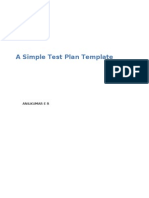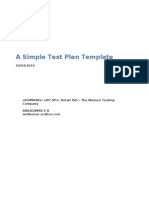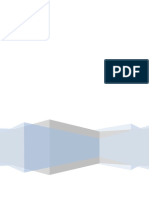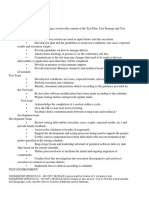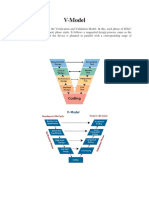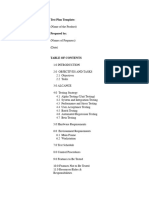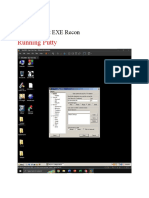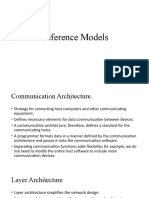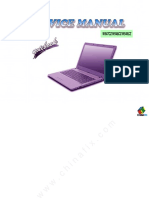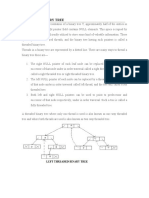Software Test Plan (STP) Template
Software Test Plan (STP) Template
Uploaded by
geopopikuCopyright:
Available Formats
Software Test Plan (STP) Template
Software Test Plan (STP) Template
Uploaded by
geopopikuOriginal Title
Copyright
Available Formats
Share this document
Did you find this document useful?
Is this content inappropriate?
Copyright:
Available Formats
Software Test Plan (STP) Template
Software Test Plan (STP) Template
Uploaded by
geopopikuCopyright:
Available Formats
Software Test Plan (STP) Template
Items that are intended to stay in as part of your document are in
bold; explanatory comments are in italic text. Plain text is used
where you might insert wording about your project.
This document is an annotated outline for a Software Test Plan,
adapted from the IEEE Standard for Software Test Documentation
(Std 829-1998).
Tailor as appropriate. Where you decide to omit a section, you might
keep the header, but insert a comment saying why you omit the
element.
Agency Name
Project Name
Software Quality Assurance Plan
Version: (n) Date: (mm/dd/yyyy)
Document History and Distribution
1. Revision History
Revision # Revision Date Description of Change Author
2. Distribution
Recipient Name Recipient Organization Distribution Method
Software Test Plan
TABLE OF CONTENTS
1. INTRODUCTION ....................................................................................................................................................1
2. TEST ITEMS ...........................................................................................................................................................3
3. FEATURES TO BE TESTED ............................................................................................................................... 4
4. FEATURES NOT TO BE TESTED ......................................................................................................................4
5. APPROACH ............................................................................................................................................................ 4
6. PASS / FAIL CRITERIA ........................................................................................................................................6
7. TESTING PROCESS .............................................................................................................................................6
8. ENVIRONMENTAL REQUIREMENTS ...............................................................................................................7
9. CHANGE MANAGEMENT PROCEDURES .......................................................................................................8
10. PLAN APPROVALS ............................................................................................................................................8
5/9/201012/4/2009 7:56:09 PM4:34:56 PM
i
Software Test Plan
1. INTRODUCTION
(NOTE 1: THE SOFTWARE TEST PLAN GUIDELINES WERE DERIVED AND
DEVELOPED FROM IEEE STANDARD FOR SOFTWARE TEST
DOCUMENTATION (829-1998)).
(Note 2: The ordering of Software Test Plan (STP) elements is not meant to imply
that the sections or subsections must be developed or presented in that order. The
order of presentation is intended for ease of use, not as a guide to preparing the
various elements of the Software Test Plan. If some or all of the content of a section
is in another document, then a reference to that material may be listed in place of
the corresponding content.)
The Introduction section of the Software Test Plan (STP) provides an overview of the project
and the product test strategy, a list of testing deliverables, the plan for development and
evolution of the STP, reference material, and agency definitions and acronyms used in the
STP.
The Software Test Plan (STP) is designed to prescribe the scope, approach, resources,
and schedule of all testing activities. The plan must identify the items to be tested, the
features to be tested, the types of testing to be performed, the personnel responsible for
testing, the resources and schedule required to complete testing, and the risks
associated with the plan.
1.1 Objectives
(Describe, at a high level, the scope, approach, resources, and schedule of the
testing activities. Provide a concise summary of the test plan objectives, the
products to be delivered, major work activities, major work products, major
milestones, required resources, and master high-level schedules, budget, and
effort requirements.)
1.2 Testing Strategy
Testing is the process of analyzing a software item to detect the differences
between existing and required conditions and to evaluate the features of the
software item. (This may appear as a specific document (such as a Test
Specification), or it may be part of the organization's standard test approach. For
each level of testing, there should be a test plan and an appropriate set of
deliverables. The test strategy should be clearly defined and the Software Test
Plan acts as the high-level test plan. Specific testing activities will have their own
test plan. Refer to section 5 of this document for a detailed list of specific test
plans.)
5/9/201012/4/2009 7:56:09 PM4:34:56 PM
1
Software Test Plan
Specific test plan components include:
Purpose for this level of test,
Items to be tested,
Features to be tested,
Features not to be tested,
Management and technical approach,
Pass / Fail criteria,
Individual roles and responsibilities,
Milestones,
Schedules, and
Risk assumptions and constraints.
1.3 Scope
(Specify the plans for producing both scheduled and unscheduled updates to the
Software Test Plan (change management). Methods for distribution of updates
shall be specified along with version control and configuration management
requirements must be defined.)
Testing will be performed at several points in the life cycle as the product is
constructed. Testing is a very 'dependent' activity. As a result, test planning
is a continuing activity performed throughout the system development life
cycle. Test plans must be developed for each level of product testing.
1.4 Reference Material
(Provide a complete list of all documents and other sources referenced in the
Software Test Plan. Reference to the following documents (when they exist) is
required for the high-level test plan:
Project authorization,
Project plan,
Quality assurance plan,
Configuration management plan,
Organization policies and procedures, and
Relevant standards.)
5/9/201012/4/2009 7:56:09 PM4:34:56 PM
2
Software Test Plan
1.5 Definitions and Acronyms
(Specify definitions of all terms and agency acronyms required to properly
interpret the Software Test Plan. Reference may be made to the Glossary of Terms
on the IRMC web page.)
2. TEST ITEMS
(Specify the test items included in the plan. Supply references to the following item
documentation:
Requirements specification,
Design specification,
Users guide,
Operations guide,
Installation guide,
Features (availability, response time),
Defect removal procedures, and
Verification and validation plans.)
2.1 Program Modules
(Outline testing to be performed by the developer for each module being
built.)
2.2 Job Control Procedures
(Describe testing to be performed on job control language (JCL), production
scheduling and control, calls, and job sequencing.)
2.3 User Procedures
(Describe the testing to be performed on all user documentation to ensure that
it is correct, complete, and comprehensive.)
2.4 Operator Procedures
5/9/201012/4/2009 7:56:09 PM4:34:56 PM
3
Software Test Plan
(Describe the testing procedures to ensure that the application can be run and
supported in a production environment (include Help Desk procedures)).
3. FEATURES TO BE TESTED
(Identify all software features and combinations of software features to be tested. Identify the
test design specifications associated with each feature and each combination of features.)
4. FEATURES NOT TO BE TESTED
(Identify all features and specific combinations of features that will not be tested along with
the reasons.)
5. APPROACH
(Describe the overall approaches to testing. The approach should be described in sufficient
detail to permit identification of the major testing tasks and estimation of the time required to
do each task. Identify the types of testing to be performed along with the methods and criteria
to be used in performing test activities. Describe the specific methods and procedures for
each type of testing. Define the detailed criteria for evaluating the test results.)
(For each level of testing there should be a test plan and the appropriate set of deliverables.
Identify the inputs required for each type of test. Specify the source of the input. Also, identify
the outputs from each type of testing and specify the purpose and format for each test output.
Specify the minimum degree of comprehensiveness desired. Identify the techniques that will
be used to judge the comprehensiveness of the testing effort. Specify any additional
completion criteria (e.g., error frequency). The techniques to be used to trace requirements
should also be specified.)
5.1 Component Testing
(Testing conducted to verify the implementation of the design for one software
element (e.g., unit, module) or a collection of software elements. Sometimes called
unit testing. The purpose of component testing is to ensure that the program logic
is complete and correct and ensuring that the component works as designed.)
5.2 Integration Testing
5/9/201012/4/2009 7:56:09 PM4:34:56 PM
4
Software Test Plan
(Testing conducted in which software elements, hardware elements, or both are
combined and tested until the entire system has been integrated. The purpose of
integration testing is to ensure that design objectives are met and ensures that the
software, as a complete entity, complies with operational requirements.
Integration testing is also called System Testing.)
5.3 Conversion Testing
(Testing to ensure that all data elements and historical data is converted from an
old system format to the new system format.)
5.4 Job Stream Testing
(Testing to ensure that the application operates in the production environment.)
5.5 Interface Testing
(Testing done to ensure that the application operates efficiently and effectively
outside the application boundary with all interface systems.)
5.6 Security Testing
(Testing done to ensure that the application systems control and auditability
features of the application are functional.)
5.7 Recovery Testing
(Testing done to ensure that application restart and backup and recovery facilities
operate as designed.)
5.8 Performance Testing
(Testing done to ensure that that the application performs to customer
expectations (response time, availability, portability, and scalability)).
5.9 Regression Testing
(Testing done to ensure that that applied changes to the application have not
adversely affected previously tested functionality.)
5/9/201012/4/2009 7:56:09 PM4:34:56 PM
5
Software Test Plan
5.10 Acceptance Testing
(Testing conducted to determine whether or not a system satisfies the acceptance
criteria and to enable the customer to determine whether or not to accept the
system. Acceptance testing ensures that customer requirements' objectives are met
and that all components are correctly included in a customer package.)
5.11 Beta Testing
(Testing, done by the customer, using a pre-release version of the product to
verify and validate that the system meets business functional requirements. The
purpose of beta testing is to detect application faults, failures, and defects.)
6. PASS / FAIL CRITERIA
(Specify the criteria to be used to determine whether each item has passed or failed
testing.)
6.1 Suspension Criteria
(Specify the criteria used to suspend all or a portion of the testing activity on test
items associated with the plan.)
6.2 Resumption Criteria
(Specify the conditions that need to be met to resume testing activities after
suspension. Specify the test items that must be repeated when testing is resumed.)
6.3 Approval Criteria
(Specify the conditions that need to be met to approve test results. Define the
formal testing approval process.)
7. TESTING PROCESS
(Identify the methods and criteria used in performing test activities. Define the specific
methods and procedures for each type of test. Define the detailed criteria for evaluating
test results.)
7.1 Test Deliverables
(Identify the deliverable documents from the test process. Test input and output
5/9/201012/4/2009 7:56:09 PM4:34:56 PM
6
Software Test Plan
data should be identified as deliverables. Testing report logs, test incident
reports, test summary reports, and metrics' reports must be considered testing
deliverables.)
7.2 Testing Tasks
(Identify the set of tasks necessary to prepare for and perform testing activities.
Identify all intertask dependencies and any specific skills required.)
7.3 Responsibilities
(Identify the groups responsible for managing, designing, preparing, executing,
witnessing, checking, and resolving test activities. These groups may include the
developers, testers, operations staff, technical support staff, data administration
staff, and the user staff.)
7.4 Resources
(Identify the resources allocated for the performance of testing tasks. Identify the
organizational elements or individuals responsible for performing testing
activities. Assign specific responsibilities. Specify resources by category. If
automated tools are to be used in testing, specify the source of the tools,
availability, and the usage requirements.)
7.5 Schedule
(Identify the high level schedule for each testing task. Establish specific
milestones for initiating and completing each type of test activity, for the
development of a comprehensive plan, for the receipt of each test input, and for
the delivery of test output. Estimate the time required to do each test activity.)
(When planning and scheduling testing activities, it must be recognized that the
testing process is iterative based on the testing task dependencies.)
8. ENVIRONMENTAL REQUIREMENTS
(Specify both the necessary and desired properties of the test environment including the
physical characteristics, communications, mode of usage, and testing supplies. Also provide
the levels of security required to perform test activities. Identify special test tools needed and
other testing needs (space, machine time, and stationary supplies. Identify the source of all
needs that is not currently available to the test group.)
8.1 Hardware
(Identify the computer hardware and network requirements needed to complete
5/9/201012/4/2009 7:56:09 PM4:34:56 PM
7
Software Test Plan
test activities.)
8.2 Software
(Identify the software requirements needed to complete testing activities.)
8.3 Security
(Identify the testing environment security and asset protection requirements.)
8.4 Tools
(Identify the special software tools, techniques, and methodologies employed in
the testing efforts. The purpose and use of each tool shall be described. Plans for
the acquisition, training, support, and qualification for each tool or technique.)
8.5 Publications
(Identify the documents and publications that are required to support testing
activities.)
8.6 Risks and Assumptions
(Identify significant constraints on testing such as test item availability, test
resource availability, and time constraints. Identify the risks and assumptions
associated with testing tasks including schedule, resources, approach and
documentation. Specify a contingency plan for each risk factor.)
9. CHANGE MANAGEMENT PROCEDURES
(Identify the software test plan change management process. Define the change initiation,
change review, and change authorization process.)
10. PLAN APPROVALS
(Identify the plan approvers. List the name, signature and date of plan approval.)
5/9/201012/4/2009 7:56:09 PM4:34:56 PM
8
You might also like
- PursuingDocument8 pagesPursuingdricardo1100% (1)
- The Software Test Engineer's Handbook, 2nd Edition: A Study Guide for the ISTQB Test Analyst and Technical Test Analyst Advanced Level Certificates 2012From EverandThe Software Test Engineer's Handbook, 2nd Edition: A Study Guide for the ISTQB Test Analyst and Technical Test Analyst Advanced Level Certificates 2012Rating: 4 out of 5 stars4/5 (5)
- DSL-340 MkIII Operators Manual V1.3Document67 pagesDSL-340 MkIII Operators Manual V1.3Kien Pham100% (1)
- Automated Software Testing Interview Questions You'll Most Likely Be AskedFrom EverandAutomated Software Testing Interview Questions You'll Most Likely Be AskedNo ratings yet
- Programmable Unitary Controller: Product DataDocument3 pagesProgrammable Unitary Controller: Product Datamanhquyet711100% (1)
- Code of EthicsDocument9 pagesCode of EthicsRomaNo ratings yet
- CDC UP Test Plan TemplateDocument9 pagesCDC UP Test Plan TemplateNitinNo ratings yet
- Unit-6 Testing PoliciesDocument10 pagesUnit-6 Testing PoliciesRavi RavalNo ratings yet
- Software Testing Notes Unit IIDocument17 pagesSoftware Testing Notes Unit IIKanchanamalaNo ratings yet
- A Simple Test Plan Template: Anilkumar E RDocument8 pagesA Simple Test Plan Template: Anilkumar E Rnimmianil100% (1)
- ST - Unit2Document58 pagesST - Unit2Aditya vtNo ratings yet
- Test Plan Template SampleDocument4 pagesTest Plan Template Samplefamigi6026No ratings yet
- Functional Test Plan: Project NameDocument5 pagesFunctional Test Plan: Project NamePrasad KshirsagarNo ratings yet
- Test Plan TemplateDocument8 pagesTest Plan TemplatenimmianilNo ratings yet
- Software Testing (Cases)Document25 pagesSoftware Testing (Cases)SwapnilNo ratings yet
- Test Plan Sample: Softwaretesting and Quality Assurance TemplatesDocument7 pagesTest Plan Sample: Softwaretesting and Quality Assurance TemplatesSnezana LazarevskaNo ratings yet
- Planning A Test and TOSDocument6 pagesPlanning A Test and TOSMichelle FuentecillaNo ratings yet
- Software Test Plan (STP) TemplateDocument12 pagesSoftware Test Plan (STP) TemplateahotangalNo ratings yet
- SQE AssignmentDocument25 pagesSQE AssignmentSaifullah KhalidNo ratings yet
- Chapter 3 SFTDocument18 pagesChapter 3 SFTtendulkarnishchalNo ratings yet
- Presentation 3Document37 pagesPresentation 3Huzef AttarNo ratings yet
- Test Plan 2013 - SoftwareDocument845 pagesTest Plan 2013 - Softwareazzuraluna801320100% (1)
- SVVPLANDocument17 pagesSVVPLANJohan JanssensNo ratings yet
- Chapter_3_Test_management till 3.2.Document18 pagesChapter_3_Test_management till 3.2.divyanshsingh70391No ratings yet
- STE Unit 3Document12 pagesSTE Unit 3sahil suryawanshiNo ratings yet
- UNIT 1 SoftwareDocument12 pagesUNIT 1 SoftwareMohideen Abdul Kader MNo ratings yet
- Test Plan Sample: Softwaretesting and Quality Assurance TemplatesDocument38 pagesTest Plan Sample: Softwaretesting and Quality Assurance TemplatesPrith GajbhiyeNo ratings yet
- Test StrategyDocument12 pagesTest Strategyapi-3831102100% (1)
- StnotesDocument3 pagesStnotessatvik johnNo ratings yet
- Group 2 End2endDocument7 pagesGroup 2 End2endenioladawkinsNo ratings yet
- Test Plan TemplateDocument9 pagesTest Plan TemplateRodica Dan100% (1)
- Sample Test Plan TemplateDocument10 pagesSample Test Plan TemplateJose Alfredo osunaNo ratings yet
- Ieee 829Document3 pagesIeee 829Sachin TewariNo ratings yet
- Unit-4 Software TestingDocument28 pagesUnit-4 Software Testingvijayakumar027personalNo ratings yet
- Sta Test-IvDocument6 pagesSta Test-Ivmanikandan02.04.2003No ratings yet
- IEEEsqapDocument30 pagesIEEEsqapDavid WessmanNo ratings yet
- IEEE-829 Test Plan FormatDocument8 pagesIEEE-829 Test Plan FormatJalal AjlanNo ratings yet
- 66423e451612764fb506e5eb Test Plan TemplateDocument5 pages66423e451612764fb506e5eb Test Plan Templatetinle084758No ratings yet
- STE-Unit3 (AY 22-23)Document4 pagesSTE-Unit3 (AY 22-23)hamza khanNo ratings yet
- SQT Ut IiDocument26 pagesSQT Ut Iisaravananvel169No ratings yet
- usability-evaluation-planDocument3 pagesusability-evaluation-planhassan.medicaldevicesNo ratings yet
- Test Plan: ScopeDocument19 pagesTest Plan: ScopeTrâm NgânNo ratings yet
- Live Project Test Plan SoftwareTestingHelpDocument6 pagesLive Project Test Plan SoftwareTestingHelpDat Tran ThanhNo ratings yet
- JISC QA PolicyDocument8 pagesJISC QA PolicyJo-Sharon UdohNo ratings yet
- Software Test Plan (STP) Template: Q:/Irm/Private/Initiati/Qa/Qaplan/TestplanDocument14 pagesSoftware Test Plan (STP) Template: Q:/Irm/Private/Initiati/Qa/Qaplan/TestplanSwapnil PatrikarNo ratings yet
- U.iii STDocument30 pagesU.iii STs39074983No ratings yet
- Software Testing Unit 3Document45 pagesSoftware Testing Unit 3sambheanup2No ratings yet
- Test PlanDocument6 pagesTest Plandivya05.b777No ratings yet
- Software Test Planning FAQDocument4 pagesSoftware Test Planning FAQVISHAL MESHRAMNo ratings yet
- ST UNIT-3Document30 pagesST UNIT-3yuvianjali7No ratings yet
- Testing Strategy: Author: PSC ConsultingDocument20 pagesTesting Strategy: Author: PSC ConsultingSadar Cm100% (1)
- Test PlanDocument18 pagesTest Planrg403152No ratings yet
- Unitech Consultancy: Test PlanDocument21 pagesUnitech Consultancy: Test PlanMohan SaiNo ratings yet
- Unit 3 ST RejinpaulDocument67 pagesUnit 3 ST Rejinpaulniet sruthimadhavanNo ratings yet
- SPMP PDFDocument7 pagesSPMP PDFjay haroldNo ratings yet
- Software Test Plan TemplateDocument13 pagesSoftware Test Plan TemplateVijay WaikarNo ratings yet
- Ys PariDocument4 pagesYs PariamnotapappaNo ratings yet
- Software Testing Unit 1Document59 pagesSoftware Testing Unit 1sambheanup2No ratings yet
- Software Testing All Questions and AnswersDocument98 pagesSoftware Testing All Questions and AnswersSeun -nuga DanielNo ratings yet
- Unit-5 SEDDocument54 pagesUnit-5 SEDjsrinithi2005No ratings yet
- Software Testing Interview Questions You'll Most Likely Be AskedFrom EverandSoftware Testing Interview Questions You'll Most Likely Be AskedNo ratings yet
- Feature Flagging with LaunchDarkly: Modern Approaches to Progressive DeploymentFrom EverandFeature Flagging with LaunchDarkly: Modern Approaches to Progressive DeploymentNo ratings yet
- ISTQB Certified Tester Advanced Level Test Manager (CTAL-TM): Practice Questions Syllabus 2012From EverandISTQB Certified Tester Advanced Level Test Manager (CTAL-TM): Practice Questions Syllabus 2012No ratings yet
- Sado Full Paper FinalDocument8 pagesSado Full Paper Finalrax dearNo ratings yet
- List of Learners Per Purok For Internet Connectivity: DirectionsDocument42 pagesList of Learners Per Purok For Internet Connectivity: DirectionsJuliefer Ann GonzalesNo ratings yet
- IAM302 - LAB18 - Ngô Hiến Hào - SE161178Document28 pagesIAM302 - LAB18 - Ngô Hiến Hào - SE161178Hào NgôNo ratings yet
- Final Synopsis PDFDocument5 pagesFinal Synopsis PDFSarthak BansalNo ratings yet
- Dbms Lab Hourly Exam Spring 2021 Muhammad Hamza Khan1)Document5 pagesDbms Lab Hourly Exam Spring 2021 Muhammad Hamza Khan1)Mohd SarwarNo ratings yet
- 6OSI ReferencemodelDocument43 pages6OSI Referencemodelgokul adethyaNo ratings yet
- Chap 03 PDFDocument30 pagesChap 03 PDFvivianguo23No ratings yet
- Tle-10 Ict Quarter 1 Module 2 (Babatuan)Document13 pagesTle-10 Ict Quarter 1 Module 2 (Babatuan)Shua HongNo ratings yet
- Qi 52 2 Sampaio p104Document7 pagesQi 52 2 Sampaio p104jcNo ratings yet
- Raheel Updated CV 2Document2 pagesRaheel Updated CV 2gourav GuptaNo ratings yet
- Synt 70 FTS: Roller Bearing Plummer Block Units, For Metric ShaftsDocument4 pagesSynt 70 FTS: Roller Bearing Plummer Block Units, For Metric ShaftsKhôi Nguyễn ThanhNo ratings yet
- Resep Minuman HerbalDocument3 pagesResep Minuman HerbalAnak HebatNo ratings yet
- Rru 4466Document28 pagesRru 4466ckiljaNo ratings yet
- MDT10P72: 1. General DescriptionDocument21 pagesMDT10P72: 1. General DescriptioniukhanNo ratings yet
- Effect Pigments From Basf: Table of ContentDocument10 pagesEffect Pigments From Basf: Table of ContentRatih AriyaniNo ratings yet
- 2.3.2.7 Lab - Preparing DataDocument4 pages2.3.2.7 Lab - Preparing Dataabdulaziz doroNo ratings yet
- Web Technology - ISolved Practical SlipsDocument30 pagesWeb Technology - ISolved Practical Slipsskshaaz06100% (1)
- 200Mhz/100Mhz/60Mhz Digital Storage Oscilloscope: Gds-2000 SeriesDocument2 pages200Mhz/100Mhz/60Mhz Digital Storage Oscilloscope: Gds-2000 SeriesCarlos MayorgaNo ratings yet
- AR - VR Infrastruture EngineerDocument148 pagesAR - VR Infrastruture Engineerelangoprt1No ratings yet
- Ethics For IT Workers and IT Users Lec 3: Instructor: Seemal Afza Seemal - Afza@ucp - Edu.pkDocument38 pagesEthics For IT Workers and IT Users Lec 3: Instructor: Seemal Afza Seemal - Afza@ucp - Edu.pkMuhammad Asad Bilal ArifNo ratings yet
- IF-Raw2Xml 22.0.0 Release NotesDocument3 pagesIF-Raw2Xml 22.0.0 Release NotesMazen SultanNo ratings yet
- W54xCZ ESMDocument94 pagesW54xCZ ESMCarlos ZarateNo ratings yet
- Threaded Binary Tree PDFDocument25 pagesThreaded Binary Tree PDFAnonymous igVRM2mA6kNo ratings yet
- Multiple Choice Questions: Answer: DDocument41 pagesMultiple Choice Questions: Answer: Dtemedebere100% (1)
- Lesson 38 - Build Applications With Glide - Part 1Document1 pageLesson 38 - Build Applications With Glide - Part 1theartofmanifesting21No ratings yet
- Imbuhan Apitan Me - Kan Siri 1 WorksheetDocument1 pageImbuhan Apitan Me - Kan Siri 1 WorksheetkhairulNo ratings yet
- Elp 452Document4 pagesElp 452PrinceNo ratings yet









